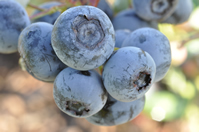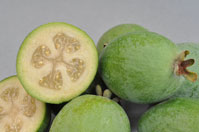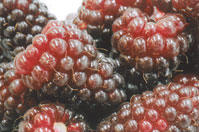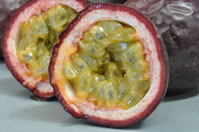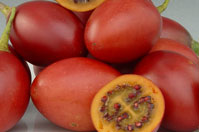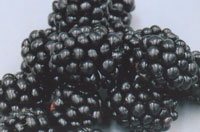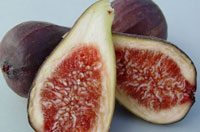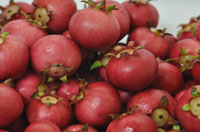
Chilean Guava |
Ugni Molinae |

|
Key Points
- Gourmet flavoured berries with un-tapped commercial potential.
- Quick to grow, easy-care crop with low establishment costs.
- Can be grown in most areas of N.Z.
- Quick returns with some fruit the first year after planting.
Climate
Temperature
Loves the heat but will withstand quite severe winter conditions.
Frost Tolerance
Soft new growth can be damaged by frost but established plants are hardy down to -6°C. The flowers appear in late spring when the danger of severe, damaging frosts has usually passed.
Chill Hours
N/A
NZ climate charts
You can read more about NZ's Cold Hardiness and Climate Zone here
Wind/Shelter
Having flexible branches and relatively small, leathery foliage, Chilean guavas appear to be impervious to all but the most severe winds some damage to ripe fruit may occur in exposed situations. Planting live shelter belts to filter prevailing winds will also help to retain orchard soil moisture in summer.
Sunshine Hours
Seems equally happy with lots of sun or semi-shaded situation but won't perform well in total shade.
Rainfall
Will survive drought and flood conditions for short periods but is happiest with a consistant supply of moisture throughout the growing period rather than extreme variations.
Soil Requirements
Soil Type
Chilean guavas can be grown in most soil types but do best in friable loams with a high organic content to help retain moisture in summer.
Drainage
Not a particular issue except where soils are water-logged for extendend periods.
pH & Soil Testing
Again, tolerant of most conditions but prefer slightly acid soils with a reasonable level of fertility. Pre-planting soil testing is useful to determine exact pH and to identify any major nutrient deficiencies.
Spacing
Can be cultivated as individual bushes or as a continuous hedge. The bushes may grow up to 2m high and 1.5m in favourable conditions but can be trimmed to suit any management regime. Allowing for headlands and machinery access between the rows, approximately 1500 plants per hectare will be required.
Crop Establishment
Selecting Varieties
Having only one variety makes selection simple.
Planting Time
In warmer districts planting can be undertaken almost year-round but in cold areas the best time would be in late spring when the danger of severe frosts has passed.
Cultivation
Eradicate perennial weeds and cultivate either the whole site or just the planting strips for the rows.
Fertiliser
Incorporate any nutrients required to achieve a suitable pH and a good base level of fertility as indicated by your soil test. Approximately 150grams of Blood and Bone per plant thoroughly mixed into the soil at planting time is the recommended way to give Chilean guavas a safe, slow-release boost as they become established.
Irrigation
Thorough irrigation is recommended at planting time to settle the young plants into position and to minimise transplant shock.
Tips
Disturb the root-ball as little as possible and plant the young trees at approximately the same depth as they are in their containers with just a light covering of soil over the roots. Tharfield Chilean guavas are trained to provided you with well-shaped plants that will require little, or no pruning at planting time.
Crop Maintenance
Fertiliser
There is as yet, no single fixed regime for fertilising commercial crops of Ugni molinae but a feeding program similar to that of blueberries can be used as a general guide.
Irrigation
Chilean guavas will bear fruit without supplementary irrigation but maintaining a consistent level of soil moisture throughout the growing season will maximise plant growth, fruit quality and total yields.
Pest & Disease Control
Remarkably free of any major pest and disease problems. Thrips can damage foliage in hot, dry conditions and, in extreme cases, may cause defoliation. However, even badly affect plants recover amazingly well when control measures are put in place.
Whether or not to apply chemical control is a decision for the individual grower to make but here at Tharfield we use an IPM Services (2009) Ltd integrated pest management program that requires us to regularly monitor our crops, to maintain high standards of nursery hygiene and, where appropriate, to make efficient use of predator insects in order to minimise the need for chemical controls.Weed Control
Young plants struggle to compete with weeds and grasses, so efficient weed control around the plants is crucial to promote maximum growth. Because the Chilean Guava has a fibrous root system that can be easily damaged by hoeing or tilling, the careful application of suitable herbicides is favoured along with regular mowing of the grass swathes between the rows.
Bird Control
Fortunately, birds appear to be disinterested in the fruit until late in the season when the berries become over-ripe and harvesting is generally completed.
Pollination
Ugni molinae bears both male and female flowers and is therefore self-fertile requiring only an active bee population to achieve good fruit set.
Harvest & Handling
Picking
The berries are a similar size to blueberries and are generally picked by hand. They have a relatively firm skin and will withstand quite robust handling so mechanical harvesting could be considered. When ripe, Chilean Guavas scent the air with an irresistable, sweetly aromatic, fruit salad fragrance.
Post Harvest
Chilean Guavas have exellent keeping qualities and suitable refrigeration can result in a fresh-fruit shelf-life of up to six weeks. The berries freeze well and have many culinary uses including jellies, sauces, ice cream and muffins.
Expected Yield
A three year old plant will produce around 1kg of fruit in average garden conditions and yields can be expected to increase by 1kg a year thereafter.
Enquiry
Please email Andrew Boylan, andrew.boylan@edible.co.nz for quotes or for any other queries you may have regarding our products and services. Minimum orders of 50 units per variety.
So that Andrew can respond to your enquiery promptly, please tell us:
- Your address (so we have some idea of your climate)
- The variety you are interested in
- The approximate numbers required
- Whether you a new grower or an established producer?
Many thanks
